If you are new to the world of welding and learning the process for the first time, it’s not unusual to be overwhelmed and confused with the wide work scope. The vast range of welding includes multiple types and each has distinct methods. And it will be more difficult to start your journey of welding without knowing these various types. While some of these processes are comparatively easy to learn, others speak a different story altogether.
There are several types of welding that can produce clean beads which are visually attractive and need no or little clean up. However, other types of welding offer absolutely opposite. Thereby the choice of metal you select for welding produces a big difference on the outcome.
Here, we will offer a comprehensive guide about welding along with its multiple types and their methods so that you can make a well informed decision.
1. TIG Welding
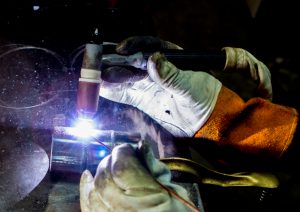 TIG welding basically refers to Heliarc and tungsten gas arc welding (GTAW). In this type of welding, there’s a non consumable electrode that is made of tungsten. It is one among those types of welding that requires no filler metal. Here two metals can be welded together smoothly. Though you can always to add a filler metal if you want, but you will need to operate by hand.
TIG welding basically refers to Heliarc and tungsten gas arc welding (GTAW). In this type of welding, there’s a non consumable electrode that is made of tungsten. It is one among those types of welding that requires no filler metal. Here two metals can be welded together smoothly. Though you can always to add a filler metal if you want, but you will need to operate by hand.
Further, a gas tank is required for TIG welding so as to produce a constant flow of gas. This is required in order to protect the weld. Therefore it’s better to perform a TIG welding indoors.
This TIG welding is a form of welding that makes visually attractive welds and it doesn’t require any cleanup. It’s due to the fact that it doesn’t produce any spatter. For such a characteristic, this is one of the difficult types of welding that should better be reserved for the expert welders.
Again, TIG welding has two types of modes, viz., pulsed current mode and dabber mode. In a pulsed current mode, the welding current smoothly alternates between dual levels. The high current condition is known as the pulse current and the low current state is known as the background current. In case of the pulsed current, the welded area gets heated and a fusion takes place. And in case of the background current, the welded area is permitted to get cold and solid.
There are various advantages of pulsed current TGI. These include a lower heat input as well as a lessening in the distortion of the thin metals. Further, this also renders greater control to the manufacturer and thereby has the potential to enhance the weld penetration, quality, and welding speed. Similarly, a manual programmed TGI lets the operator to channel a precise rate and immense level of current modes that makes it beneficial for customized and special applications.
Dabber – The dabber is another variation of TGI modes. It is used in order to specifically place the weld metal on their thin edges. The process is automatic and it minutely replicates the movements of manual welding. It is fed by a hot or cold filler wire in the welded area and oscillating or dabbing it in the arc. It can also be used with respect to the pulsed current. This is utilized while welding an immense range of alloys like nickel, titanium and tool steels. Several applications such as building seals in the engines, making milling cutters, saw blades, mower blades, and drill bits.
2. Flux Cored Arc Welding (FCAW)
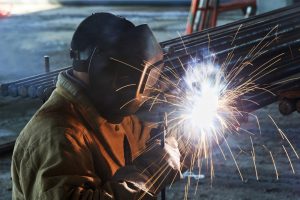 Flux Cored Arc Welding is an automatic or semi automatic process of welding. This sort of welding is almost akin to MIG welding. Basically, MIG welders can perform Flux Cored Arc Welding with equal efficiency. However, there are a few differences between the duo of course. As in the case of MIG welding, a wire serves like an electrode and you need to feed the filler metal with your own. This is the point when things start to differ. In case of FCAW the wire possesses a core of flux which builds a gas shield round the weld. This fact removes the necessity of having an external gas supply.
Flux Cored Arc Welding is an automatic or semi automatic process of welding. This sort of welding is almost akin to MIG welding. Basically, MIG welders can perform Flux Cored Arc Welding with equal efficiency. However, there are a few differences between the duo of course. As in the case of MIG welding, a wire serves like an electrode and you need to feed the filler metal with your own. This is the point when things start to differ. In case of FCAW the wire possesses a core of flux which builds a gas shield round the weld. This fact removes the necessity of having an external gas supply.
If the metal is heavy and thick, FCAW is ideal due to the reason that this is a high heat welding process. It’s sometimes also used for heavy instrument repairs. This is an efficient process which creates little or no waste. Also, as there’s no necessity to have an external gas supply, the process cost you less.
However, bear in mind that there will be some left over slag and it will require certain cleanup after the procedure if you want to produce a beautiful finishing on the weld.
There can be various types of FCAW welding technique. One of its types requires no protective gas. This has been possible by its range of flux core in its tubular electrode. But this core possesses several other ingredients other than flux. These ingredients, once exposed to the great temperature of welding, create a shield gas around the arc to protect it. Such sort of FCAW is preferable to many technicians since it can be easily penetrated into the base metal. Further, wind and rainy conditions are not suitable for this. Some drawbacks are also there while using this sort of welding. For instance, the process can make immense amount of smoke which makes it difficult to check the condition of weld fool. This can be risky as well. Therefore proper electrode needs to be chosen in this welding process if you seek to obtain the desired results. Skill is yet another major factor because if improper electrode or machine is manipulated, it may cause life threatening results.
Another type of FCAW requires a gas shielding that needs to be supplied through an external agent. This is also called as dual shield welding. This form of FCAW emerged mainly for welding steel. It uses both the external shield gas as well as a flux cored electrode; it can also be called GMAW or gas metal flux cored welding. Mainly, shield gases are argon carbon dioxide or regular carbon dioxide blends. Most often the blend utilized is 75% argon with 25% of carbon dioxide.
If the welding is thick and made of out of position metals, this style of FCAW comes in handy. The slag made of the flux is quite easy to remove. The primary advantage of this process is that it can be carried out in an enclosed garage. It makes welds more of mechanical quality.
However, it should not be carried out in a windy or stormy environment because the loss of gas shield due to the air flow may end up producing porosity in the weld.
3. Shielded Metal Arc Welding (Stick)
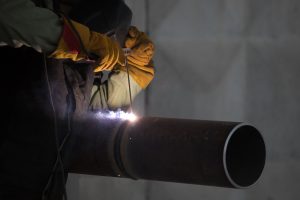 Shielded Metal Arc Welding is the type of welding that began in 1930s and kept up its fame as one of the most updated welding process even today. Though with the advancement of technology the process too got improved, the basic agenda or concept and method remain the same. Since it is one of the easy and simple welding processes to learn and implement, it doesn’t require much cost while operating.
Shielded Metal Arc Welding is the type of welding that began in 1930s and kept up its fame as one of the most updated welding process even today. Though with the advancement of technology the process too got improved, the basic agenda or concept and method remain the same. Since it is one of the easy and simple welding processes to learn and implement, it doesn’t require much cost while operating.
You need to keep in mind that the welding method splatters easily, therefore it’s not the neatest weld procedure. Hence clean up is mandatory when it comes to Shielded Metal Arc Welding.
Here an electrode stick plays the role of the filler metal. The arc is made which connects the end of the stick with the base metal. This further melts the electrode and makes filler metal in order to create the weld.
The stick is coated with flux which produces a gas cloud on heating up. This gas cloud protects the metal from getting oxidized. And when it cools down, the gas sticks on the metal and thereby it becomes slag.
This process can be carried out in the outdoors even during rain and wind or any adverse weather, the reason being the fact that the process doesn’t need any external gas supply. This type of welding process is also applicable on painted, rusted or dirty surface. Hence it’s the ideal sort of welding for any kind of instrument repairs. Various types of electrodes are used here that are easily available in the market and also easy to swap. Therefore the welding process is suitable to weld various kinds of metals.
However, keep in mind that the process is not ideal for thin metals. Also, only experienced and expert technicians can carry out Shielded Metal Arc Welding process efficiently. Therefore if you are new to welding world, don’t start with this type of welding and only with long practice and immense knowledge can you master this process.
4. MIG Welding
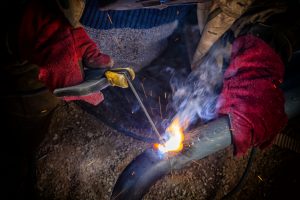 MIG welding is one of the simple forms of welding that requires not much effort. Therefore novice technicians can start their career with this type of welding. MIG is a short form for Metal Inert Gas and it is often known as gas metal arc welding or GMAW.
MIG welding is one of the simple forms of welding that requires not much effort. Therefore novice technicians can start their career with this type of welding. MIG is a short form for Metal Inert Gas and it is often known as gas metal arc welding or GMAW.
This quick process of welding includes a filler metal that is needed to be fed with a wand. The gas makes a cloud around it in order to shield the metal from the external elements. Hence, the process shouldn’t be carried out in the external environment. Nevertheless, it’s an efficient procedure and can also be used for numerous types of metals. The metals belong to different thicknesses.
Its filler metal plays the role of the electrode though its shape is like a consumable wire. It can be fed through a spool.
As the wire connects with the base metal, it melts and thereby acts as the filler metal and creates the weld as a consequence. The arc is thus created. The wire is continually supported by the wand. This allows one to run the process in a preferable speed. Once you gain efficiency at this process, MIG welding can offer a tight and smooth weld which is visually attractive.
There can be various transfer forms of MIG welding such as short circuit transfer, spray transfer, and pulsed spray transfer. In case of short circuit transfer, the wire touches the metal. Electricity runs through the gun and thereby produces a short circuit. The wire is melted and it creates a puddle between the work pieces. Here carbon dioxide shield gas is used with a low voltage. Further, minimum amount of shielded gas is needed which makes the entire transfer type a cheaper process.
In the form of spray transfer, the wire melts in little droplets and then gets sprayed like mists. It starts to make a hissing tone at first then crackle with popping sound. It is effective in creating cleaner arc between the welding materials and gun. Argon shield gas or regular shield gas with at least 15% carbon di oxide when combined with high voltage, such a welding is achieved. The gas is relatively expensive since it contains high argon amount.
In case of the globular transfer, similar combination of argon shielding gas and high voltage is used. In this form of MIG welding, melted metal is collected and drips gradually. However, its main disadvantage is that it spatters a lot.
The process of pulsed spray transfer results in an alteration between globular forms and spray. Such a method doesn’t require much voltage support in order to weld products. As a result, high efficiency weld is produced. The MIG welding is much expensive but offers great functionality and exhibits high function.
5. Laser Beam Welding
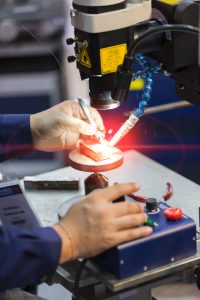 Laser Beam Welding is that type of welding which can be used on thermoplastics or other metals. As its name implies, it includes the utilization of the laser as the heat source in order to create welds. Further, it can also be used on HSLA steels, stainless steel, aluminium, carbon steels, and titanium.
Laser Beam Welding is that type of welding which can be used on thermoplastics or other metals. As its name implies, it includes the utilization of the laser as the heat source in order to create welds. Further, it can also be used on HSLA steels, stainless steel, aluminium, carbon steels, and titanium.
It can be easily implemented on robotics and hence often used during manufacturing especially in the automotive industry.
Laser welding can generally be accomplished in two main ways – keyhole welding and heat conduction welding. In the process of keyhole welding, the laser ray warms the metal in a manner that the surface gets vaporized and thereby the metal is dug deeper. This results in a keyhole where the plasma type condition is formed as the temperature rises over 10,000K.
And in case of the heat conduction process, the metal base is heated over the melting point of the respective metal but not to the point where it can be vaporized. This method is implemented when the metal doesn’t require excessive weld strength. The positive point of hot conducive welding is the fact that the resulting weld will get extremely smooth and produce an aesthetic effect. Low laser power in the range below 500W is utilized for the heat conduction welding.
6. Electron Beam Welding
Electron Beam Welding is that sort of welding where the high potential electron beams produce heat with the help of kinetic energy created during welding two materials. This is one of the most sophisticated forms of welding which is operated by a machine, most usually in a vacuum.
7. Plasma Arc Welding
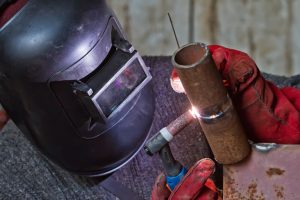 Plasma Arc Welding is almost akin to GTAW though it makes a smaller arc. Therefore, here’s more chance of obtaining a précised result. It utilizes a distinct torch that helps to achieve a higher temperature. The gas gets pressurized inside its wand. As a result, it creates plasma. Then the plasma is ionized which makes the weld electrically conductive. This creates the arc and produces extremely high temperatures that may melt the base metal. This further renders the plasma arc weld to let it perform without any filler metal. This is yet another similarity with the TIG welding type.
Plasma Arc Welding is almost akin to GTAW though it makes a smaller arc. Therefore, here’s more chance of obtaining a précised result. It utilizes a distinct torch that helps to achieve a higher temperature. The gas gets pressurized inside its wand. As a result, it creates plasma. Then the plasma is ionized which makes the weld electrically conductive. This creates the arc and produces extremely high temperatures that may melt the base metal. This further renders the plasma arc weld to let it perform without any filler metal. This is yet another similarity with the TIG welding type.
Plasma Arc Welding lets deep penetration into the welding with the help of narrow welds. This produces visibly pleasant weld and a high level of strength. Further, high welding speeds are available as well.
Plasma Arc Welding can be distinguished in multiple types. For example, transferred Plasma Arc Welding method utilizes a direct DC current. Here the metal is allied to the positive funnel and the tungsten electrode needs to be allied to the negative terminal. The arc is built among the tungsten electrode along with the work portion. Here both the plasma and the arc moves alongside and are directed toward the work portion. This in turn enhances the heating capacity and this process is thereby used while joining the solid sheets.
Again in the case of non transferred Plasma Arc Welding method, polarity DC current is used. Here the nozzle is connected with the positive funnel while the tungsten electrode is connected with the negative pole. The arc is generated among the tungsten electrode inside the torch as well as in the nozzle. Thereby it enhances the ionization of the concerned gas inside the torch. The torch thereby transfers the ionized gas to the next step. Unlike the earlier one, this form of Plasma Arc Welding method is generally applied while joining thin sheets.
8. Atomic Hydrogen Welding
Atomic Hydrogen Welding is that type of welding that produces excessively high heat from the arc atom welding. This sort of welding includes the utilization of hydrogen gas that protects two electrodes which are made of tungsten. It can also reach the optimum temperatures beyond the acetylene torch and can be operated either with or without any filler metal.
Though this type of welding is a traditional and relatively old method of welding, nevertheless it is still relevant and preferable by many. However, many users prefer MIG welding over this type of welding which is comparatively a new one.
9. Electroslag
This is one of the advanced methods of welding. This is generally used while combining the thin edges of two metal plates. These plates are conjoined together in a vertical manner. Here, instead of applying the weld outside a joint, it takes place in the middle of the edges of these two metal plates.
In this process, the copper electrode wire is with the help of a consumable metal wire that also plays the role of a filler metal. When the electricity is given to it, the arc is produced. Thus the weld starts at the bottom part of the funnel and then slowly rises up. This makes the weld take place on the upper part. This automated process requires less or no manual involvement and can be performed by the machine. Therefore a thorough knowledge of machines and automated procedures is necessary to produce such a weld. Hence it’s not always ideal for the beginners. As the technicians grow an expertise in the field and practice the process thoroughly, they can try their hands at such welding.
As mentioned, a wholesome knowledge of welding is important if you want to see yourself as an expert welder anytime soon. Learning all these types of welding require several things including patience, time, and enthusiasm. Some of these welding procedures are easy to carry out as we discussed before. Beginners can learn these more easily and in relatively lower time. However, some welding methods require immense proficiency in the field and need experts’ advice. While carrying out such procedures, you need to be supervised by the learned technicians so as not to affect your health. However, as you achieve expertise and gain experience, you can produce amazing welding with beautiful finish.
Also, remember that clean up is an integral part of welding because if the welding causes a lot of splatter, then your space will be messy and become a safety hazard. Also, every type of welding comes with individual requirement and precautions. While some types of welding can be carried out in adverse situation and environments like wind, storm, rain or in the outdoor space, some forms of welding need to be accomplished only in the indoor space due to more sensitive gas shield. Hence, keep an eye on the type of welding you need to carry out and take any measure accordingly.